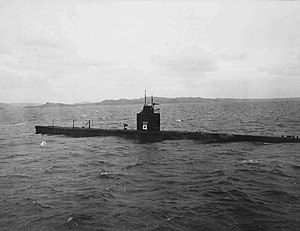Postwar
In November 1945, I-203 departed Maizuru bound for Sasebo, Japan, which she reached on 25 November 1945. [5] The Japanese struck her from the Navy list on 30 November 1945. [4] [5] On 12 December 1945, she got underway from Sasebo for sea trials, manned by a U.S. Navy crew and a skeleton Imperial Japanese Navy crew. [5] Between 28 December 1945 and 8 January 1946, she and I-201 put to sea from Sasebo for a series of short sea trials with U.S. Navy crews, supported by the U.S. Navy submarine tender USS Euryale. [5]
At 07:30 on 13 January 1946, I-201 and I-203 got underway from Sasebo in company with Euryale and the rescue and salvage ship USS Current bound for Pearl Harbor, Hawaii, with stops planned at Guam in the Mariana Islands, Eniwetok in the Marshall Islands, and Johnston Atoll. [5] [6] The vessels proceeded due south toward Guam in a column formation, with Euryale in the lead followed by I-201, I-203, and Current, with each vessel 1,500 yards (1,370 m) from the vessel ahead and astern of her. [6] While proceeding to Guam, the ships rode out a typhoon, during which both submarines suffered engine breakdowns and I-201 had a steering failure. [5] [6] After repairs at sea, the ships arrived at Apra Harbor on Guam at 16:15 on 21 January 1946, receiving a boisterous welcome. [5] [6] The crews were granted shore leave on Guam. [5]
The vessels departed Guam on 25 January 1946 on the next leg of their voyage. [6] I-203 again suffered engine failure on 29 January that reportedly forced her to spend an additional night at sea, [5] although she also reportedly reached Eniwetok on 31 January 1946 along with the rest of the vessels. [5] [6] The formation commander decided to skip the planned stop at Johnston Atoll and proceed directly from Eniwetok to Pearl Harbor. [5] A direct trip from Eniwetok to Pearl Harbor exceeded I-201′s and I-203′s range, so he ordered the two submarines to be towed. [6] At 07:00 on 2 February 1946, the vessels left Eniwetok. [5] The formation arrived at Pearl Harbor on 13 February 1946, and I-201 and I-203 entered a caretaker status there with skeleton crews while the U.S. Navy studied their design. [5]
